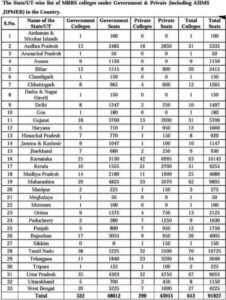In a special issue done for GIM 2019 in February 2019, we presented a detailed report on the credentials of Chennai, for its claim as the leader in medical education and healthcare. In April 2020 IE issue, we pointed to the vast differences among the states in the state of medicare.
We referred in particular to the tiny Union Territory of Puducherry having more number of medical colleges than the large state of Bihar. Has the situation changed?
I append a table on the number of medical colleges – government and private – and the total number of seats offered by these in different states. An interesting feature of this is the continued expansion of these in the southern region with 238 colleges and 37,130 seats [India’s total: 612 colleges and 91,927 seats] and the continued low growth of these in the north and the east.
SOUTHERN STATES FLY HIGH…
Colleges in the southern states of Andhra Pradesh, Karnataka, Kerala, Tamil Nadu, Puducherry and Telangana offer nearly 40.3 per cent of the total 91,927 MBBS seats in the country. Of these, Karnataka (10,145 seats) and Tamil Nadu (10,725 seats) have nearly 22.7 per cent of the seats.
Tamil Nadu has the largest number of MBBS seats in government medical colleges (5225 seats in 38 colleges), followed by Uttar Pradesh (4303 in 35), Maharashtra (4825 in 29), Gujarat (3700 in 8) and West Bengal (3225 in 20). Sikkim is the only state without a single government medical college. It has one private medical college with 150 MBBS seats.
Karnataka has the highest number of MBBS seats in private medical colleges (6995 seats in 42 colleges), followed by Tamil Nadu (5500 in 32), Maharashtra (5070 in 33), Uttar Pradesh (4750 in 32) and Telangana (3200 in 23).
TAMIL NADU TOPS IN MEDICARE
Over the last four decades, after Chief Minister M G Ramachandran opened up medical education to the private sector, Tamil Nadu has recorded a spectacular growth. In 2021-22 the state added 11 medical colleges ensuring at least one each in every district. Tamil Nadu leads with 10,725 medical seats. States in the Hindi belt, notably, Uttar Pradesh, has been recording high growth. Disappointingly, Bihar continues to lag.
The Centre has been quite liberal in funding the spread of medical education. There is need for state administrations to avail these and improve their healthcare infrastructure. Covid-19 has reinforced the need for this. India has the capability to rev up healthcare well-demonstrated by gearing up the facilities across the country.
Completing 202.17 crore shots of Covid-19 vaccination in a short time is a global record. Today there is the willingness and capability to step up financial allocation for healthcare and to spend it effectively. Such efforts should be continued to spread medical education and hospital facilities uniformly across the country.

